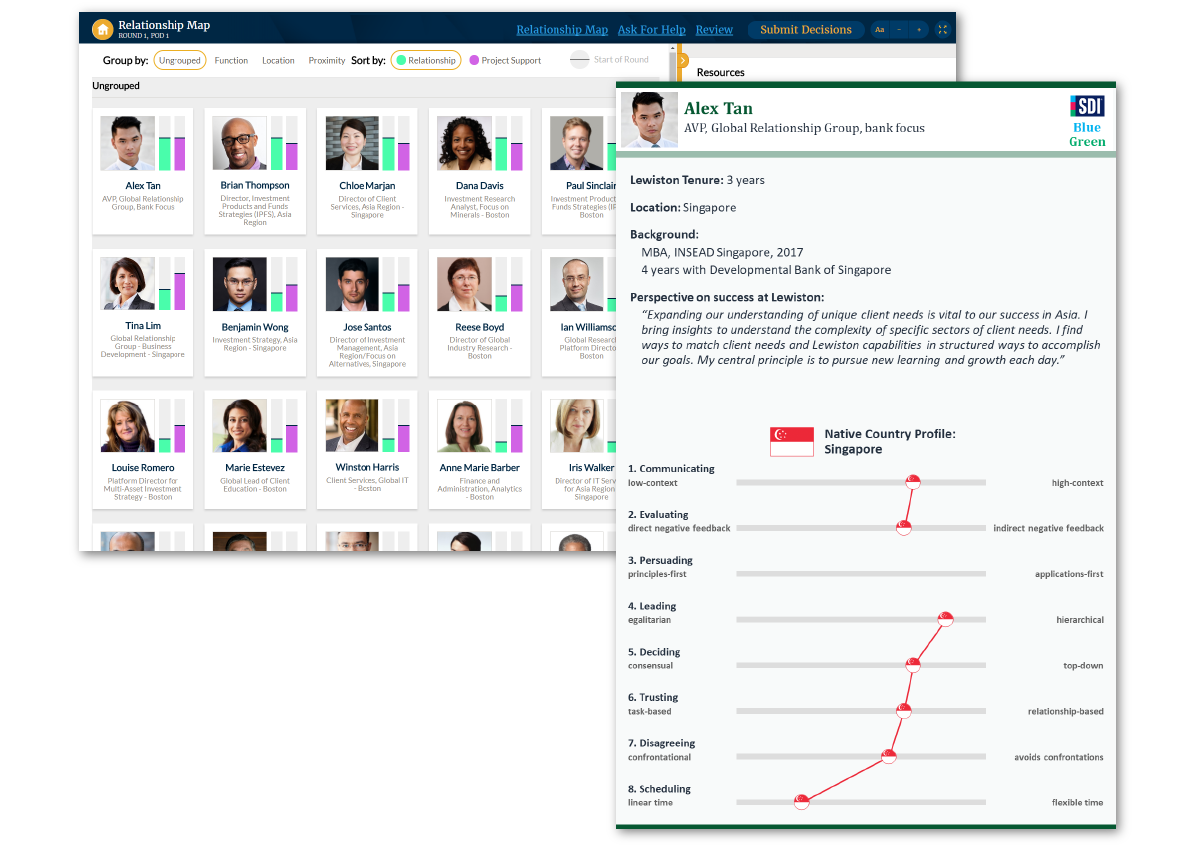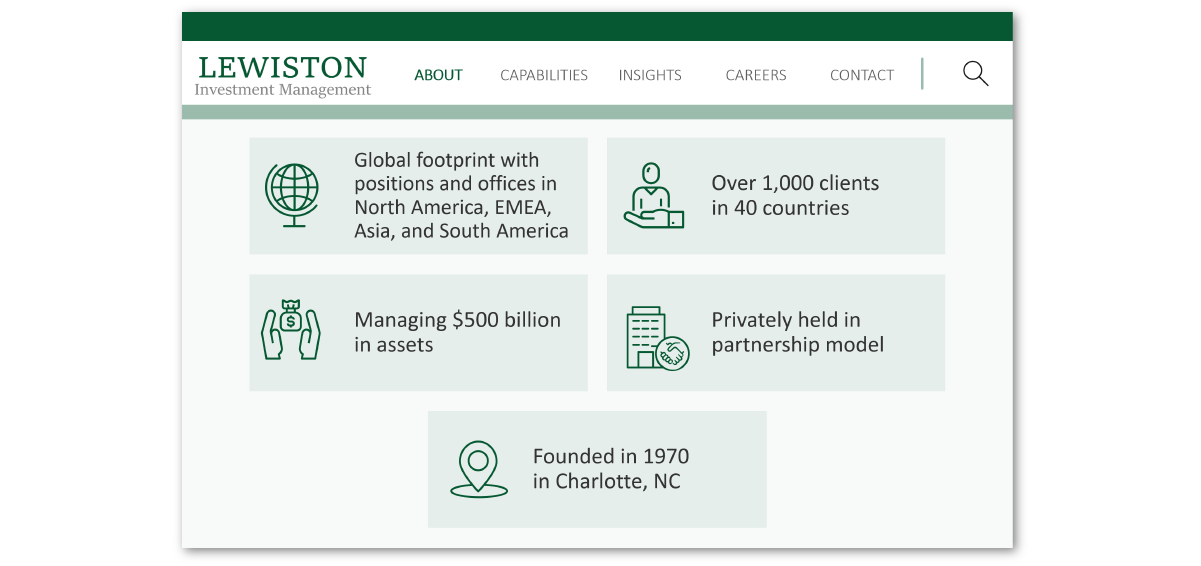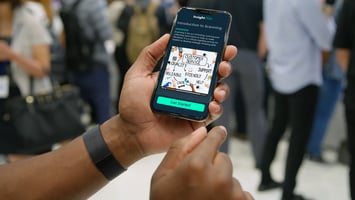Navigating the Organization:
Developing Young, Non-Dominant Leaders in Building Relationships for Success
Abstract
A global investment firm wants to accelerate the development of high-potential, young, non-dominant employees in order to benefit from increased diversity and inclusion.

Challenge
A firm wants to offer a virtual leadership program that will help young high performers understand how to build effective relationships with their peers and superiors to enhance their effectiveness, their influence, and how they are perceived. The program is designed to be a learning journey that allows for frequent practice, the reinforcement of concepts, and coaching over time.
Solution
Insight Experience designed a robust three-module business simulation that is delivered by a global facilitation team in conjunction with small-group coaching and bite-size learning content. Each simulation module maps to a phase in the solution development process used by the client firm and creates continuity for the program by reinforcing the content that participants have most recently completed. Throughout the simulation experience, teams make decisions about trigger scenarios — challenging issues that young, non-dominant groups often face back on the job — and business choices, such as making recommendations regarding fee levels. Teams also make choices about how to best interact with coworkers at all levels of the organization, based on their global profile, SDI, and current relationship and project support status. Ultimately, the teams that are able to network and develop better relationships throughout the experience are more likely to achieve stronger business results.
Learning Objectives
Participants:
- Learn to think strategically, build relationships, and lead themselves, their team, and their colleagues.
- Practice and experience interactions and skills in order to accelerate professional development.
- Work with peers in an activity that provides an opportunity to share experiences.
- Build understanding of the stages and challenges of developing a client solution or a new product.
- Apply client templates and tools, even if abbreviated.
- Prepare for the Strategic Challenge Project at the end of the leadership development program.
Design Highlights
The program's design highlights organizational personalities. The business simulation includes more than 20 stakeholders, each representing archetypes of various personalities that are found within the global firm. Simulation participants have access to the background of each stakeholder and a relationship map tool to show their current level of relationship and project support.
In addition, the business simulation mirrors the solution development process of the client firm — from solution selling to implementation.
The Navigating the Organization program accommodates cross-organizational learning. The virtual delivery enables participants from different geographies to learn together, accommodating multiple time zones and generating cross-geography insights.
It also provides opportunities for conversation and presentations. Participants complete four role plays and, in order to bring key content to life, deliver a presentation to senior leaders within the context of the business simulation.

Program Agenda
The Navigating the Organization program is delivered in three week-long modules that are approximately one month apart. In these week-long sessions, participants complete bite-size learning, coaching, and simulation activities. These activities evolve throughout the course of the program:
Module One: Leading Self
 |
 |
 |
|
Simulation Team |
Observed |
Simulation Team |
Module Two: Navigating the Organization
 |
 |
|||
|
|
Simulation Team |
|
Presentation to |
|
 |
 |
|||
|
|
Observed |
|
Simulation Team |
|
To maintain continuity between simulation rounds, participants receive two types of reports. Teams receive a feedback report after the decision discussion; this includes more details about the impacts of their choices. And before the next round of decision-making, they receive a project update report that explains how the project has progressed as a result of previous choices. To bring the program to a close, the final simulation debriefs trace the arc of the solution development process end to end and show comparative results from cohorts spanning three global geographies.
Simulation Overview
Each team collectively assumes the role of Product Manager at a fictitious company called Lewiston Investment Management. In their simulation role, participants are responsible for gathering the insights and resources to develop the most appropriate solution for the client by thinking strategically and building relationships. Teams are based in Singapore, requiring them to work with both local and global Lewiston leaders.
History and Results
Since its launch in 2020, more than 120 participants from across the globe have completed the Navigating the Organization program.
In the final simulation debrief, participants are asked to reflect by sharing one learning from the business simulation experience, an insight they plan to take back to their job. Some of the responses received thus far include:
- “Be more mindful of my daily interactions. Try to build brand.”
- “Focus on creating a diverse network; ask questions.”
- “Intentional networking; knowing the value I bring.”
- “Focus on the people aspect and make a connection.”
- “Little things matter, it’s important to be intentional.”
- “Be conscious in decision making to effectively lead change.”
- “Be brave.”
Here is what some participants have said about the program:
- “When pulling together a presentation, I’ve always considered 'my audience' in the level of detail I include, the tone, and my overall approach. Before the simulation, I hadn’t applied that preparation to my day-to-day interactions. The simulation has prompted me (even years later) to stop and be more deliberate in every communication I make to increase the likelihood of a successful outcome. Only takes a few moments but has had a significant impact on my essentiality!”
- “Really enjoy this program. I appreciate how important these simulations are to my growth and how difficult it is to create an effective simulator.”
- “Thank you for the facilitation, it was great. Really enjoyed the time spent with my sim team. Felt like a way to network while also learning on the job, which is the type of networking that I enjoy the most/find most useful (vs. coffee chats). I find I can develop deeper relationships when partnering cross-functionally to solve problems.”










